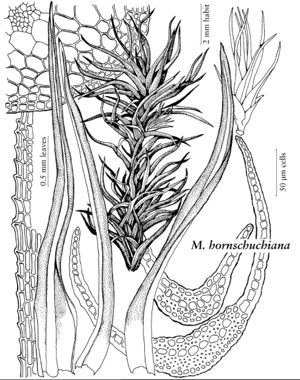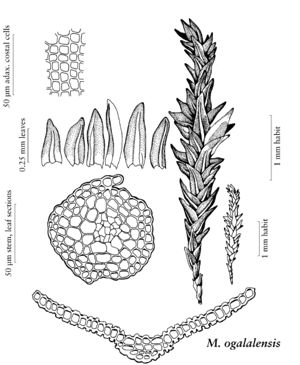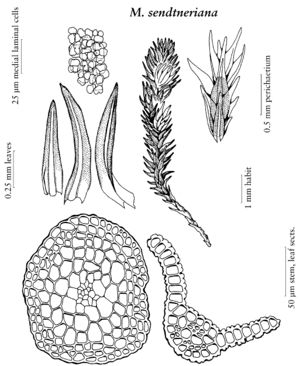Molendoa
Utkast Eur. Bladmoss., 29. 1878 ,.
| Taxon | Illustrator ⠉ | |
|---|---|---|
 | Molendoa hornschuchiana | Patricia M. Eckel |
 | Molendoa ogalalensis | Patricia M. Eckel |
 | Molendoa sendtneriana | Patricia M. Eckel |
Plants forming a compact turf, dark to light green, occasionally glaucous above, brown or tan below. Stems elongate, to 2 [–7] cm; hyalodermis absent or occasionally weakly developed, sclerodermis absent or present, usually weak, central strand present, usually strong; axillary hairs of several 1-seriate cells, usually thin-walled or occasionally proximal 1–2 cells thick-walled. Leaves usually crowded, appressed-incurved to weakly spreading, usually twisted, occasionally tubulose when dry, spreading to spreading-recurved when moist; variously ovate, ligulate, long-oblong, linear, ovate to linear-lanceolate, adaxial surface flat to broadly or narrowly channeled; base scarcely differentiated to elliptic-sheathing; distal margins plane to weakly recurved in proximal 1/2, entire or occasionally sinuolate, occasionally denticulate at shoulders, distal margins often 2-stratose entirely or in patches; apex broadly rounded to narrowly acute; costa ending 1–3 (–6) cells before apex, percurrent, or excurrent as a stout mucro, adaxial outgrowths absent, adaxial cells quadrate to elongate, in 2–7 rows; transverse-section circular, semicircular or reniform, adaxial epidermis present, adaxial stereid band absent to weak, guide cells 2–7 in 1 layer, hydroid strand absent, abaxial stereid band present, crescentlike or rounded in sectional shape, abaxial epidermis usually present, weakly developed; proximal cells differentiated across leaf or differentiated area V or U-shaped, rectangular, little wider than the distal cells, (1–) 2–5: 1, walls of proximal cells thin or evenly thickened to porose; distal medial cells often irregular in shape, roundedquadrate, oval, rounded-triangular, ca. 8–10 µm wide, 1: 1; papillae crowded, low, irregular, scablike, occasionally simple to 2-fid or massively multifid, cell-walls evenly thickened to weakly trigonous, flat to bulging superficially, superficial walls usually thicker than internal walls. Specialized asexual reproduction by axillary gemmae, rarely present, obovoid to spindle-shaped, ca. 35–50 µm, multicellular. Sexual condition dioicous. Perichaetia terminal on short lateral branches, interior leaves usually highly differentiated, sheathing the seta, ovatelanceolate, usually shorter than the cauline leaves, often marginally serrulate, laminal cells rhomboid in proximal 1/2 to throughout. [Seta 0.2–0.7 cm. Capsule stegocarpous, theca ovoid to cylindric, often macrostomous, 0.6–1.5 mm, annulus of 2–3 rows of transversely elongated, hexagonal cells, weakly vesiculose; operculum long-rostrate, oblique, of untwisted cells; peristome absent. Calyptra cucullate. Spores ca. 9–12 µm.] KOH laminal color reaction yellow to yellow-orange.
Distribution
Worldwide except Australia and Antarctica
Discussion
Species 15 (3 in the flora).
Molendoa has lateral perichaetia, as is also the case with Anoectangium and Pleurochaete in the Pottiaceae. The costa of Molendoa has two stereid bands (in robust specimens at least), and the distal lamina may be 2-stratose at least in patches.
Selected References
Key
| 1 | Stem sclerodermis lacking or very weakly differentiated, distal laminal cell superficial walls of same thickness as the internal walls, each cell with a single large papilla, this simple or weakly 2-fid. | Molendoa ogalalensis |
| 1 | Stem sclerodermis present, sometimes poorly differentiated, distal laminal cell superficial walls usually thicker than the internal walls, cells multi-papillose | > 2 |
| 2 | Leaves 3-4 mm, long-lanceolate; apex subulate; leaf base broadened and sheathing, ovate-rectangular, shoulders denticulate with projecting corners of marginal cells; costa semilunar in section, guide cells 4-9; distal laminal cells often longitudinally elongate, lamina rarely 2-stratose. | Molendoa hornschuchiana |
| 2 | Leaves 1-2(-2.5) mm, ovate to short-lanceolate; apex broadly rounded to acute; leaf base not or weakly differentiated, occasionally ovate, margins entire; costa round to semicircular in section, guide cells 2-4; distal laminal cells mostly quadrate, lamina often 2-stratose marginally, especially in small plants. | Molendoa sendtneriana |